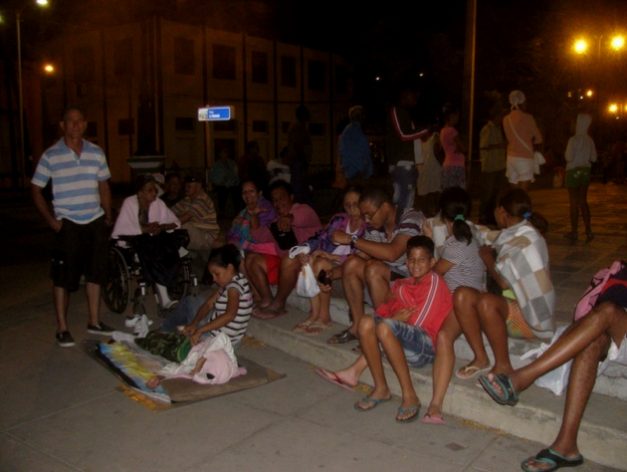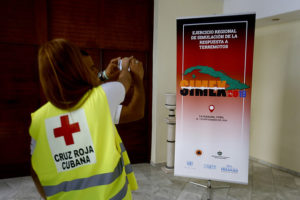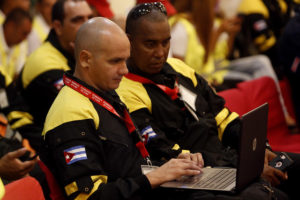Cuban Communities Prepare for a Potential Large Earthquake

By Luis Brizuela (IPS)
HAVANA TIMES – Marcia Videaux always keeps a bag with a first aid kit in plain sight in her living room. This little detail, as well as her swift and calm response in the event of an earthquake could be a matter of life and death for herself and her family.
This forms part of the 48-year-old textile worker’s training, which she has acquired via TV ads, leaflets or drills, living in the city of Santiago de Cuba, the second most important in the country, around 500 miles south-east of Havana.
“An earth tremor (the popular term for earthquakes on the island) lasts seconds, sometimes you don’t have time to react; in these instances, I’ve picked up my two children, the bag with a first aid kit and we’ve gone to a nearby park, in case of possible aftershocks,” Videaux told IPS.
Unlike the island’s central and western provinces, where only very light tremors are felt, Santiago de Cuba is where more intense earthquakes are felt more regularly.
Along with its neighboring provinces of Granma, Guantanamo and Holguin, all of which are found in the island’s far-east, they are at the greatest risk of suffering an earthquake because they are very close to the Cayman Trough.
This transform fault zone forms part of the active tectonic boundary between the North American Plate and the Caribbean Plate, and strong seismic movements have been recorded in its surroundings.
In Cuba, between five and six thousand earth tremors of varying magnitudes are recorded on average, every year. The last mighty earthquake took place on May 25, 1992 in cape Cabo Cruz, in Granma, measuring 6.9 on the Richter scale (the highest being 10).
However, the most devastating earthquake took place on February 3, 1932, in Santiago de Cuba in fact, with a death toll of 15, some 400 injured and 80% of buildings damaged.

Ever since 2016, little seismic activity has been recorded in the area. Experts from the government agency National Seismological Research Center (CENAIS), created in 1992 and based in this city, believe that this silent build-up of energy inside the Earth could well lead to an earthquake measuring over 7 on the Richter scale.
“The likelihood of a high-intensity earthquake in Cuba is real. It would be irresponsible to say otherwise. Tectonic plates have been moving for millions of years and pressure builds with this movement, CENAIS director O’Leary Gonzalez tells IPS.
“We don’t know when it will happen, but high resolution seismic measurements show that it is a lurking reality,” the official concluded in the Cuban capital, where he took part in the Regional Earthquake Response Simulation Exercise, known as SIMEX 2019.
According to experts, earthquakes in this country take place every 80-100 years and in Santiago de Cuba, the strongest earthquake dates back 87 years already.
SIMEX took place from September 16-20 in Havana, sponsored by the National Headquarters of Cuba’s Civil Defense, and with approximately 270 Cuban and foreign experts from 17 different countries taking part.
It was also endorsed by the United Nations Office for the Coordination of Humanitarian Affairs (OCHA), the International Search and Rescue Advisory Group and the Pan American Health Organization. Support for the event came from funds and programs of UN agencies in Cuba, international cooperation agencies and NGOs based in this Caribbean country.
The program featured conferences and a practical exercise, with a view to share experiences and coordinate both a national response as well as an international agencies’ response to this kind of phenomenon.
Raul Costa, head of the Natural and Technological Disaster Reduction unit at Cuba’s Civil Defense, highlighted the fact that the Cuban Red Cross has the mission of training up 5% of the population (11.2 million inhabitants on the island) in light rescue techniques and first aid.
During the theory sessions, the director stressed that the population and rescue and relief community groups play an essential role within the national strategy for disaster risk reduction.
Luis Enrique Calero, head of the Cuban Red Cross’ Rescue Operations and Relief department, underlined the fact that rescue and relief community groups are made up of volunteers, who are trained to carry out prevention, response and recovery actions at a local-level.
“These groups, which act at a local, municipal and provincial-level, are the first to respond to a disaster with relief actions and first aid assistance. They train people, support vulnerable groups such as the disabled and elderly; and guarantee the protection and evacuation of schools, maternity hospitals and residences for the elderly,” Calero told IPS.

He also pointed out that the Cuban Red Cross is currently training a group of women as health brigades, as requested by the Federation of Cuban Women.
“Most are housewives or workers who stay at home in their free time. We want to get to the point where this population group can train up their own family and neighbors; so that they have a greater understanding of the risks involved and respond better when these disasters take place,” he argued.
Henry Boveda, a 30-year-old freelance worker living in the Jimenez neighborhood, also in Santiago de Cuba, was unaware of the existence of these groups, but assured IPS that they know what to do in this city if there was an earthquake.
“We’re taught ever since we’re children at school, while local TV broadcasts with earthquake-related guidelines. The important thing is to keep calm, and to stay under a door frame or a table. When the earthquake is over, we should leave the house for a while out of precaution, because there could be possible aftershocks, and so we should head for open spaces,” Boveda explains.
Experts consulted by IPS during SIMEX claimed that the systematic training of Cuban citizens could result in a 70-80% better chance of surviving an earthquake.
Every year, before hurricane season starts (June-November), the government makes a call for the popular drill “Meteoro”, to adapt response actions in the face of possible damages caused by hurricanes and intense rain. These drills also include initiatives to reduce the effects of earthquakes in more vulnerable areas.
There are twenty-something seismology stations across the island, 15 of which are based in the country’s East and the rest are found in the central and western provinces. They all contribute data to the national and regional seismic activity monitoring network.
The government has modernized these installations in recent years, and they boost local-level bodies to monitor and provide an early response in the case of an earthquake.





